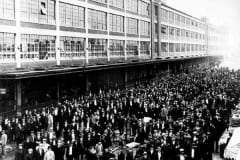It may be that one of the most important sites in automotive history - home to the first moving assembly line and the place where workers wages first offered $5 per day - but today there are some signs, to show the importance of the old Ford plant in the struggling Detroit suburb of Highland Park behind the T-model name on a neighboring shopping center.
That can change its way if a motor city community and economic development group. The Woodward Avenue action Association, known as WA3, launches a new Crowdsource fundraiser to save not only the historical factory but may help, as a tourist and Learning Center, which is under the options under study for the building of the future.
WA3's new crowdsourcing campaign is a first modest. The group needs $550,000 to acquire several of the other buildings on the property. It received more than $400,000 grants and now hopes to secure an another $125,000 to purchase.
Eventually, organizers say they will need more money to start restoration and renovation.
Highland Park assembly plant was designed by the legendary architect Albert Kahn and formerly known as Crystal Palace because of its large Windows and abundant natural light, actually to produce the third Ford Motor factory and the second t-model but with great demand for his "Tin Lizzie" Henry Ford urgently required to increase production.
He had to, to ensure a reliable source of work at a time when workers regularly end due to the grueling demands of the automotive assembly line. The industry pioneer wages begin with $5 per day led.
But Ford had another motive in mind. It created a new class of increasingly wealthy customers, he to right suppose T model instead of the tram to work would also buy.
The factory opened in 1910 but continued, that Ford to fight booming demand for the small cars. He came up with an idea, taken from the reverse, which pushed the slaughterhouses of the Midwest where carcasses where chop meat along a conveyor belt, each worker from a particular item.
Highland Park began T body along a conveyor belt - partially assembled model first by rope - workers at each station assigned, to complete a particular task.
The move helped Ford continuously reduce production costs, the price for the FLIVVER from $800, drop, when it was first introduced on only 300 dollars at the end of the year run its course.
The system taxes and jobs contributed to increasingly outdated make the community surrounding in one of the wealthiest in the country, but despite his initial breakthroughs that plant grew up with several stories and what was once described as largely motor gave up "the factory which changed the world" at the end of the 1920s as Ford still massively built complex opened Detroit's Rouge River.
Some component and tractor Assembly operations took a while, but the system largely been abandoned, with some parts as a warehouse company and a section as a clothing warehouse to survive. The surrounding suburbs has also faded, and now is under financial emergency management.
Will added despite the national historic landmark registry in 1978, gave it concerns that it could be the old model T work like so many other once-prosperous Detroit factories suffer - as the Packard plant a few miles away, which steadily, the prospect of saving grows increasingly dim collapse was the same fate has.
The "$5-day" campaign has a deadline of Sept. 19 for the first financing package complete. It could particularly attached, because this period comes just a few weeks before the 100th anniversary of the moving assembly line, a statement from Ford mentioned, began on October 7, 1913, "create and define the industrial age."







0 коммент.:
Post a Comment